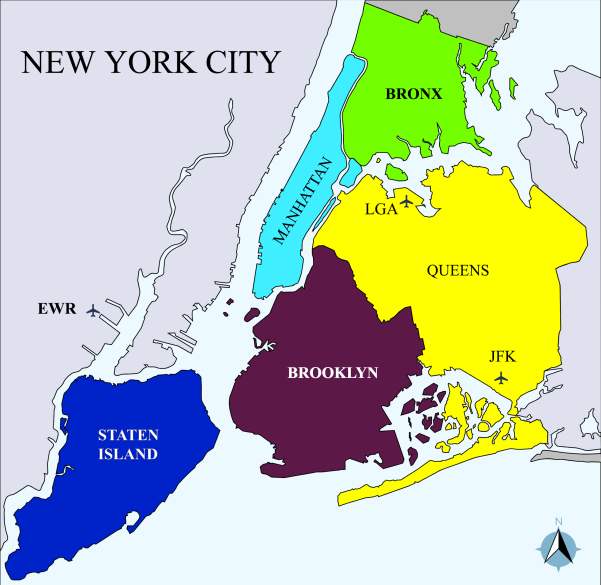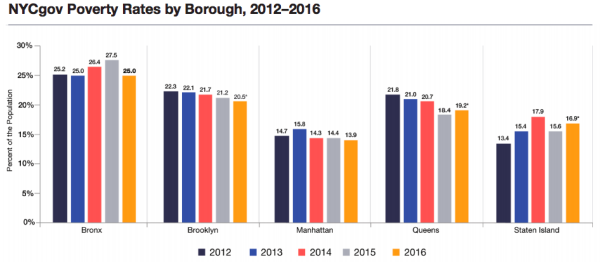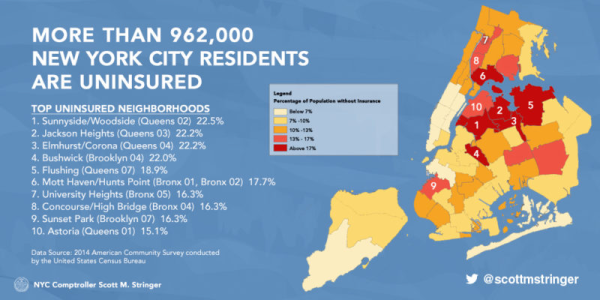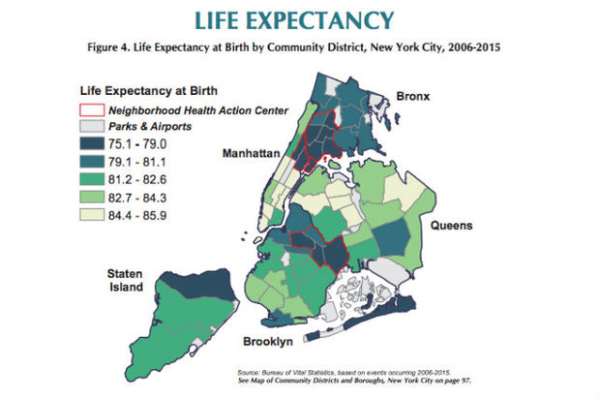By Matt Burdett, 27 June 2019.
In this article, we look at the incidence of poverty, deprivation and informal activity (housing and industry) in urban areas at varying stages of development
New York City: A brief introduction
New York, New York – not just so nice they named it twice, but in reality because New York the city is in New York the state. This page uses ‘New York’ to refer to the city, not the state.
New York began as New Amsterdam, a colony of the Dutch, who lost it in 1664 to the British (History.Com, 2010). Over the next three hundred years, the city became ever more important as a port and as a magnet for migrants from Europe and the rest of the world, resulting in modern New York being one of the most globalised cities in the world.
Today, New York is part of a conurbation, surrounded by other urbanised areas including New Jersey and the rest of Long Island. It is made up of five districts (see map below) with a population of 8.2 million (NYC Planning, 2017).

- New York City’s five boroughs. Source: Rodrigo.Argenton, 2015.
Poverty, deprivation, informal housing and informal industry
Poverty
Although few people in New York live in absolute poverty, defined as “a condition where household income is below a necessary level to maintain basic living standards (food, shelter, housing)”, there is widespread relative poverty, which is defined as “a condition where household income is a certain percentage below median incomes” (Pettinger, 2017). In 2016, around 20% of New Yorkers lived in poverty, with around 46% living in near-poverty (NYC Mayor’s Office, 2018). This is partly due to the very high incomes of a minority of New Yorkers which skews the data; however, it is also due to the higher costs of living in New York compared to other US cities which means the boundary for being in relative poverty is higher than elsewhere, so more people fit under it.

- Poverty rates in New York City. Source: NYC Mayor’s Office, 2018, p13

- Patterns of poverty in New York City. Source: NYC Mayor’s Office, 2018, p30
The reasons for this variation in poverty in space and time are contested. The spatial variation is likely to be due to a combination of factors which are linked to social deprivation, lack of education and healthcare, lack of affordable housing, crime and social problems, and so on. The apparent decrease over time has been credited by the mayor’s office to projects such as Homeless Outreach and Mobile Engagement Street Action Teams (HOME-STAT), the New York City ‘Rent Freeze’ Programme, and programmes such as paid family leave and paid sick leave. However, some critics have claimed it is because the poorest people are leaving the city due to high rent for housing (Toure, 2018).
Deprivation
Deprivation relates to lack of person’s access to the things that people in a society consider to be normal, such as diet, clothing, housing, as well as healthcare, education and recreation, among many others (Mack, 2016). Across New York, there are patterns of deprivation.
Deprivation: Lack of access to healthcare
For example, in terms of health insurance, in 2014 a report by the New York City Comptroller found that around 10% of the population were uninsured, and that these people were largely found in the same places where poverty was highest.

- Uninsured NYC residents, 2014. Source: Brooklyn Reader, 2015.
This lack of health insurance is compounded by the lack of public health providers. People without health insurance were forced to use free clinics at hospitals where they would be treated for all their health concerns. However, 16 hospitals, including 4 in Brooklyn, closed between 2003 and 2017 (Ford, 2017). One of the results of this lack of access to healthcare has been a pattern of life expectancy that varies in the city, and of the cause of death also varying. Diseases of affluence, such as heart disease and cancer, kill people in the wealthier areas of the city while diseases of poverty, such as diabetes and hepititis, kill more people in the poorer areas – but, this is likely because people in the wealthier areas avoid deaths from treatable diseases, and eventually they die of something else.

- Source: US Department of Health, via Rizzi, 2017.
Informal housing
The Department of Housing Preservation and Development is the government department responsible for housing in New York City. Historically, New York had poor quality housing, but this was mostly removed in the 1920s and 1930s (Garcia, 2012). Informal housing doesn’t exist in New York in the same way that it does in Nairobi, for example. However, there is evidence of informal housing in other forms, such as:
- Squats: Abandoned housing is taken over by squatters
- Lofts: Informal and unofficial rooftop dwellings are added to buildings
- Illegal conversions: Buildings that were not designed for housing (and often don’t have the required infrastructure such as adequate bathrooms) are converted to housing without permission from the authorities
These informal housing types are the living spaces for the same marginalised groups of people that are found in lower income countries, especially new and impoverished migrants (Waldrep, 2014). However, there is very little information about the distribution of such informal housing, nor the amount. With several government programmes for affordable housing (NYC HPD, n.d.) along with tight regulation of the construction industry, the spread of informal housing is kept in check. Around 62,000 people who cannot find a place to live are instead forced to sleep in homeless shelters. Those who cannot access the shelters sleep on streets, subway trains and other public spaces, but there are no accurate figures on this (Coalition for the Homeless, 2018).
Informal industry
Informal industry in New York City is not common. There is no significant informal heavy industry or even light manufacturing. As with all large cities, there is a signifacant informal service sector. People work as maids, casual labourers, and so on. The patterns of informal industry fit the HIC description in the page on this site ‘Urban poverty, deprivation and informal activity’.
Sources
Brooklyn Reader, 2015. Comptroller’s Report on Healthcare: Number of Uninsured NY’ers Drops Only 2 Percent; Higher Enrollment Still Needed. https://www.bkreader.com/2015/11/comptroller-healthcare-report-number-of-uninsured-nyers-drops-2-percent-higher-enrollment-still-needed/
Coalition for the Homeless, 2018. New York City Homelessness: The Basic Facts. http://www.coalitionforthehomeless.org/wp-content/uploads/2018/05/NYCHomelessnessFactSheet-3-2018_citations.pdf
Ford, 2017. Hospital Closures and Medicaid Shifts Took Toll on NYC’s Health. https://citylimits.org/2017/01/04/hospital-closures-and-medicaid-shifts-took-toll-on-nycs-health/
Garcia, 2012. Great Question: How Did Slum Clearance Impact Neighborhoods?